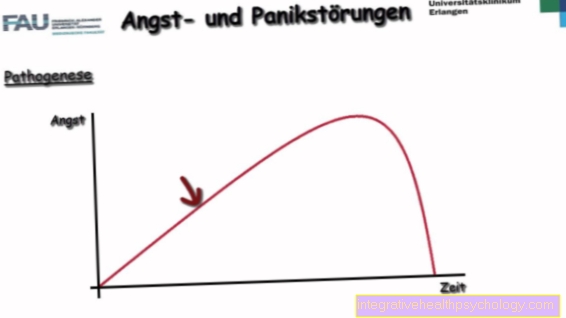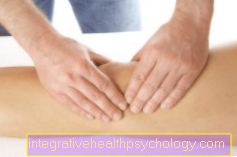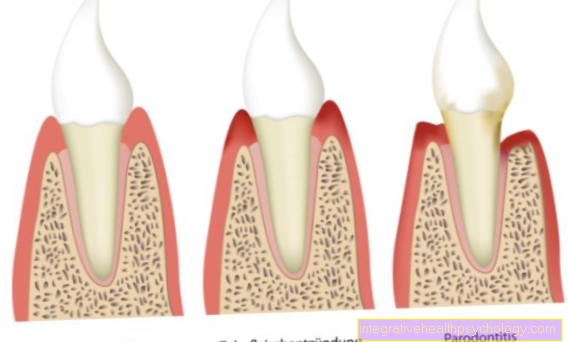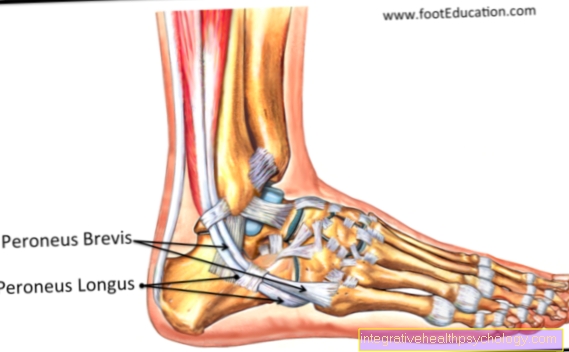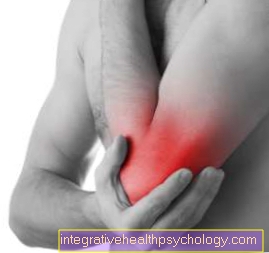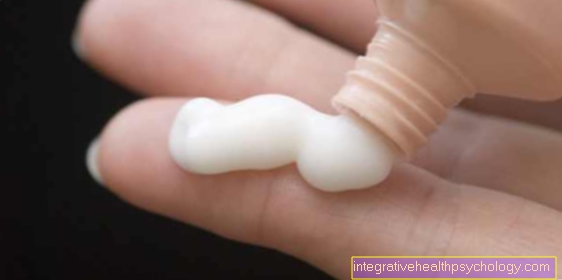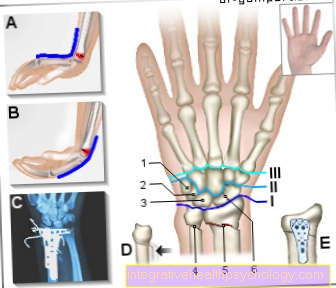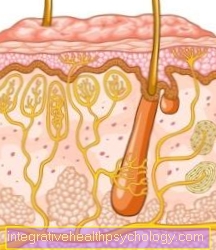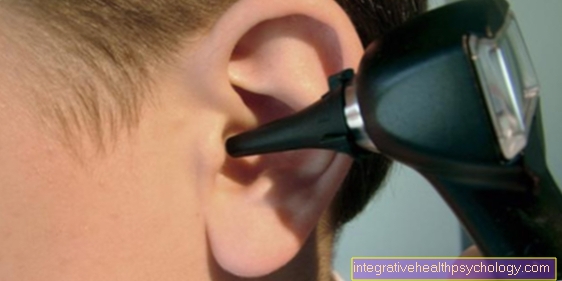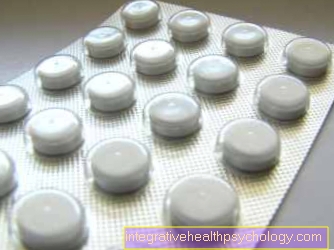Tightening of the skin on the upper arm
synonym
Brachioplasty
introduction
In young people, the skin and subcutaneous fat tissue in the area of the upper arms are closely attached to the muscular structures.
Because of this, the arm looks young, healthy and taut.
In the course of aging, however, the elasticity of the tissue decreases significantly.
For many people, this leads to the development of unattractive-looking upper arms.
In addition, many patients who have lost large amounts of weight suffer from slack upper arms.
The reason for this is the fact that after years of obesity, the skin is very stretched.
Adhering to a healthy diet and regular training sessions can help to break down fatty tissue, but this way, excess skin can only be reduced to a limited extent.
For many people, this fact represents an enormous psychological burden.
After the success of the weight loss, most of those affected are still dissatisfied with their body image due to the overhanging remains of skin on the stomach, thighs and / or upper arms.
Aesthetic surgery can help the affected patient by performing a so-called upper arm lift (technical term: Brachioplasty) Create a remedy.

Performing the upper arm lift
The upper arm lift is a surgical procedure in which sagging skin flaps between the armpit and elbow are removed and the remaining areas of skin tightened.
Basically, an upper arm lift is not just about removing excess skin.
Rather, this surgical measure comprises several partial aspects.
When performing an upper arm lift, the overall appearance of the upper arms is improved by not only smoothing the skin but also reducing excess fat deposits.
In addition, the supporting tissue located under the skin, which is responsible for the actual shape of the upper arm, can be tightened.
After a successful upper arm lift, the contours and proportions of the arm emerge more clearly, the upper arm looks more powerful, younger and healthy.
However, people who decide to have an upper arm lift should have realistic ideas about the outcome of the treatment before the operation.
In addition, the patient must be aware that fine scars will remain on the inside and / or back of the upper arms after the operation.
What are the scars?
With the classic surgical upper arm lift, scars cannot be avoided, as skin incisions have to be made to remove the fatty tissue and excess skin.
The likelihood of scarring increases with the size of the skin sections to be removed.
Basically, the incision is made in the armpit and made towards the elbow along the inside or back of the upper arm.
Later on, scars can appear along these sewn-up skin sections.
In addition, there are also factors that favor the development of post-operative scars.
The risk of scars developing is increased in smokers, as the nicotine can cause circulatory disorders in the skin.
Patients with wound healing disorders are also more likely to have residual scars.
In addition, aftercare of the wound plays an important role.
Those who follow the doctor's instructions and do not put weight on the upper arms too early will encourage the wounds to heal faster and better and reduce the risk of large, noticeable scars.
Upper arm lift through liposuction

The aesthetic-surgical upper arm lift involves enormous risks and leaves clearly visible scars on the inside and back of the upper arms.
Regular training sessions can counteract minor loss of elasticity in the skin in the area of the upper arms, but pronounced skin flaps can hardly be removed in this way.
Nevertheless, many of those affected are wondering whether there is an alternative to a surgical upper arm lift.
Some specialist clinics now offer special liposuction (Technical term: liposuction) in the area of the upper arms.
Specialists assume that the appearance of the arms can in many cases be significantly improved with a simple liposuction.
However, the upper arm lift with liposuction can only be successful if the patient's skin still has a certain degree of elasticity.
So before thinking about surgical correction, those affected should first talk to a specialist about less invasive procedures.
However, the upper arm lift by liposuction is not comparable to a conventional liposuction.
In order to improve the contour of the upper arm and to rejuvenate the appearance of the arms, special suction techniques are carried out.
However, the patient should note that the upper arm lift by liposuction also carries certain risks.
Performing an anesthetic can lead to circulatory and cardiac arrhythmias.
Furthermore, breathing can be negatively affected under anesthesia.
In some cases, following artificial respiration during anesthesia, the development of inflammatory processes in the respiratory tract and / or the lungs (pneumonia) has been observed.
Since surgical incisions have to be made for the upper arm lift, too, tiny nerve fibers can be injured.
As a result, the affected patient can suffer from temporary or permanent sensitivity disorders.
Heavy bleeding can occur during and after the upper arm lift with liposuction.
In addition, there is also the risk of wound healing disorders and swelling in the area of the operation with this procedure.
In general, however, the upper arm lift with liposuction is much safer than the classic surgical skin flap removal.
However, patients considering an upper arm lift with liposuction should be realistic about the outcome of the treatment.
With the help of this method, pronounced loss of elasticity cannot be eliminated.
For patients who suffer from slack upper arms after severe weight loss, the upper arm lift with liposuction is usually not an option.
How much does an arm lift cost?
The actual cost of an arm lift depends on various factors.
In addition to the condition of the tissue and skin, the selected surgical method and the scope of treatment play a decisive role in the cost calculation.
In general, one can assume that the cost of performing an upper arm lift is between 2000 and 5000 euros.
The price for an upper arm lift also differs enormously between the individual German cities.
In most cases, aesthetic operations are offered much cheaper in small towns than in large cities.
The quality of the surgical procedure does not correlate in any way with the level of treatment costs.
In addition, upper arm lifts are also offered abroad for several hundred euros cheaper.
However, people who are thinking about having the upper arm lift carried out abroad should inform themselves in advance about clinics, doctors, operating and hygiene standards.
The rumor "Aesthetic operations abroad are generally worse than at home“Is no longer true.
When does the health insurance company cover the costs?
Basically, it should be noted that an upper arm lift is a cosmetic procedure that in most cases has no medical indication.
For this reason, neither statutory nor private health insurances cover the costs for surgery, anesthesia, inpatient stay, medication and aftercare treatments.
Furthermore, it must be clear to the patient who is planning to perform an upper arm lift that all subsequent costs will not be covered by the insurance.
In detail, this means that if the surgical procedure results in bleeding, wound healing disorders, infections or the like, all the resulting treatment costs must be paid by the patient himself.
As with many other surgical interventions, the health insurance company will only assume the costs if the necessity of the intervention is medically justified.
It depends on the health insurance company whether they cover all of the costs or only pay part of them.
Examples of this can be:
-
large excess of skin as a result of weight loss
-
Inflammation
-
Rashes in the areas of the upper arms
-
good personal hygiene in these areas is no longer feasible
Before the operation, the costs must be applied for.
If these costs are fully covered by the health insurance, nothing stands in the way of the operation.
As mentioned above, only part of the costs can be covered by the health insurance company.
The patient then has to pay for the remaining costs. Many clinics also offer the option of paying in installments.
Does additional insurance make sense?
In order to prevent the incurrence of immensely high costs, some additional insurance companies offer special tariffs geared towards cosmetic and aesthetic operations.
People who are planning such an operation can therefore insure themselves against the costs of follow-up treatments before performing the operation.
In most cases, these insurances cover all follow-up costs that arise in the course of a calendar year after the date of the operation.
On average, the institutions in question demand for this protection (depending on the planned procedure) a one-time insurance premium of 80 to 150 euros.
In addition, "unsuccessful“Cosmetic surgeries are covered in special rates.
The insurance carrier then takes on any further necessary corrective operations.
In this context, however, patients should note that the insurance policy must be taken out at least 24 hours before the planned surgery date.
This is how the operation works
The op (surgery) for upper arm lift is usually performed under general anesthesia.
Depending on the initial condition and the necessary scope of correction, the duration of the operation is approximately one to two hours.
After the operation, an inpatient stay of 1 to 3 days is necessary, as there is a particularly high risk of secondary bleeding and wound infections during this time.
On the day of the upper arm lift, the areas in which excess tissue and skin must be removed are drawn on the skin before the operation begins.
The patient is then given a light sedative and anesthesia is initiated about half an hour later.
The incision and length depends on how much excess skin has to be removed during the operation.
In addition, the quality (Thickness and elasticity) the skin plays a decisive role in the choice of the ideal incision.
In most cases, the surgical incision is made on the inside or back of the upper arm.
If the skin and subcutaneous tissue are markedly slack, this incision can extend from the armpit to the elbow. During the operation, the excess skin is simply cut out.
If necessary, excess skin can be removed with liposuction (Liposuction) be combined.
After the skin flap has been removed, the surgeon begins to tighten the remaining skin and stretch it smoothly over the upper arm.
Following the actual upper arm lift, the surgical incisions must be closed again.
When the skin is closed, a so-called "minimally invasive“Procedure carried out. The attending physician uses special, self-dissolving threads that fall out by themselves after a while.
The removal of sutures after about 10 to 12 days is therefore not necessary after an upper arm lift.
Since the skin in the area of the upper arm is very tense after the operation, the seam is additionally supported with a skin adhesive. After the upper arm lift, the surgical field must be cleaned and covered with a simple bandage. In this way, wound infections and excessive swelling can be avoided.
What are the complications?

Like any medical operation, the purely aesthetic upper arm lift carries a number of risks.
Since the surgical treatment of excess skin flaps in the area of the upper arm usually has to be carried out under general anesthesia, circulatory and heart failure can occur during the operation.
In addition, breathing can be severely impaired by the influence of the anesthetic.
Since the patient has to be ventilated through a tube in the windpipe during anesthesia, injuries to the airways can occur.
In addition, after such ventilation there is an increased risk of developing pneumonia (pneumonia).
The specific risks for an upper arm lift correlate with the length and the exact location of the surgical incisions.
A long, far-reaching cut usually leads to problems more often than short cuts.
Since both the skin and the structures immediately below the skin surface are severed, damage to the smallest nerve fibers can occur.
For the patient, this has the consequence that the sensitivity of the upper arm in question is severely limited.
However, loss of sensitivity of this kind can regress within a few months.
In addition, there is a risk of high blood loss before and after the upper arm lift.
For this reason, patients with congenital bleeding disorders or low blood platelet counts should refrain from performing such an operation.
Furthermore, after the upper arm lift, inflammatory processes in the area of the operation and / or wound healing disorders can occur.
Complication wound healing disorder
Wound healing disorder is one of the general risks that affect any surgery.
Usually, however, it rarely occurs in the context of an upper arm lift, but is among other things also dependent on specialist medical skills.
To minimize the risk of impaired wound healing, smokers should avoid nicotine a few weeks before the procedure if possible.
Nicotine can lead to circulatory disorders, which can impair wound healing after the operation.
Alternatives to classic surgery
After an upper arm lift, visible scars are usually left on the inner and back of the upper arm.
Many people want tighter upper arms, but are unsettled because of the scarring.
The multitude of possible risks also discourages many from performing an upper arm lift.
In the meantime, however, there are ways to improve the appearance of the arms without having to undergo an operation.
Nowadays, an upper arm lift should even be possible without any visible scars.
In the case of slight loss of elasticity in the skin on the upper arms, special exercises can help to tighten the affected areas.
There are a number of exercises for lifting the upper arm, but these hardly help in very pronounced cases.
Read more about this: Exercises against cellulite
The easiest way to tone your upper arms is to lift weights. Alternatively, full water bottles or similar items can also be used.
With this method, the upper arm is lifted primarily by building up the muscles and reducing excess fatty tissue at the same time.
In addition, regular push-ups can be seen as an effective measure for tightening slack upper arm tissue.
Diet should also have a decisive influence on the appearance of the arm area.
With a slight loss of elasticity in the skin of the upper arm, a significant change in diet can already contribute to tightening.
For this reason, those affected should avoid unhealthy foods such as junk food.
In general, your diet should be as balanced as possible.
This means that meals should consist of a good balance of protein, carbohydrates and healthy fats.
In addition, care should be taken to ensure that sufficient amounts of energy sources (e.g. carbohydrates) are consumed at breakfast.
In this way, the metabolism can get going at the beginning of the day and fat burning can be stimulated.
Drinking enough water is part of a balanced diet.
An adult should drink at least eight glasses of water during the day.
Upper arm lift using liposuction
The most important and best alternative to the classic upper arm lift is liposuction.
This method can lead to a significant tightening of the skin on the upper arm, especially in slim people.
In liposuction (technical term: Liposuction) primarily adipose tissue is removed.
The effects of this procedure are not limited to a reduction in fat cells in the upper arm area.
Rather, a so-called "Skin shrinking“(Skin shrinkage).
By using special suction techniques, which differ significantly from conventional liposuction, the slack skin can be animated to shrink from the inside. In this way, the proportion of excess skin tissue is greatly reduced and the upper arm appears firmer and younger.
In contrast to the classic upper arm lift, this method creates no / hardly visible scars.
Although an upper arm lift by liposuction is much more gentle on the tissue than the classic procedure, there are also some risks with this method.
In the area of the treated areas, nerve damage can also occur during liposuction.
In addition, there is also the risk of inflammatory processes developing. In some patients, wound healing disorders, bleeding and swelling were also observed.
Upper arm lift with laser
An alternative to the classic upper arm lift surgery is laser lift.
Pulses are emitted by a neodymium YAG laser via fibers inserted into the tissue, whereby fat cells shrink and the surrounding connective tissue is tightened.
The patient is placed in a twilight sleep anesthesia throughout the treatment.
The advantages compared to the classic operation are that no scars remain and the patient can go back to his everyday activities after a few days. The upper arm lift with the laser also means that the risk of vessel damage is very low.
Upper arm lift by means of thread lifting
Another alternative to the classic upper arm lift surgery is the tightening of the upper arms using a thread lift.
Here, thin, well-tolerated threads are passed through the skin.
The skin regions are drawn together by the barbs on the threads and the threads are enclosed by the tissue.
This leads to the tightening of the upper arms.
The advantages over conventional surgery are that there are no scarring.
In addition, the threads no longer have to be removed as they will dissolve on their own after about a year.
How can you tighten your upper arms through training?
There are numerous exercises with which the upper arm muscles are built up, i.e. one increases in muscle volume.
If the upper arm muscles are specifically and maximally stressed through exercises, proteins are built into the resulting micro-injuries of the muscles.
As a result, the muscles increase in volume and the upper arms become firmer.
Dips are a good exercise for toning the upper arms.
Here you support yourself with your hands on a bench or the edge of a chair and push your bottom towards the floor.
Then it is raised again and the triceps muscles are contracted.
If you do this exercise 8-12 times and repeat it 2-3 times every other day, you will quickly achieve a change in the limp upper arms.
Would you like to know how to lose weight on the upper arm? Then read the following article:
How to lose weight on the upper arm!
More interesting information
You may also be interested in other interesting articles about aesthetic surgery:
- Strengthen connective tissue
- Cellulite
- Tummy tuck
- Breast lift
- Thigh lift
- Liposuction
- Vibratory lipolysis
All topics from cosmetic surgery can be found here.


